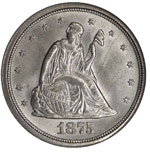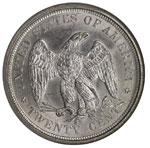
Grading Twenty Cents (1875-1878)

|

|
| Click to enlarge | |
Little more than a curious footnote in the history of United States coinage, the twenty-cent piece of 1875-78 is nevertheless a collectable coin by type and by date. The justification for producing this denomination (which actually makes more sense in a decimal system than the quarter dollar) is that the discontinuation of the silver half dime in 1873 had left those living in the western United States without a five-cent piece. Nickels didn't circulate in the West, but then neither had half dimes to any great extent. It seems likely that the real reason for producing a new denomination in silver was simply to provide an additional outlet for this metal. The production of domestically mined silver was growing at the same time as its price was falling, and the congressional delegations from the silver producing states and territories managed to get a bill passed authorizing this needless coin.
The twenty-cent piece debuted in 1875, and the mints at Philadelphia, Carson City and San Francisco all minted them for circulation that year. San Francisco dropped out in 1876, and most of the 10,000 pieces coined in Nevada were withheld from release and subsequently melted. It had taken just a few months to establish that this coin was not wanted. Only proofs were coined in 1877-78, after which time this denomination was discontinued altogether. Its failure was attributable to its similarity in size and design to the quarter dollar. The twenty-cent piece did have a plain edge, but then so did the quarters in circulation after a few years of wear.
Though not popular with the public, those twenty-cent pieces which did enter circulation appear to have remained there for many years, as they are often found quite worn. In most respects grading circulated twenty-cent pieces is similar to grading the other Seated Liberty coins. One exception is found in the raised letters of LIBERTY, as opposed to the incused letters of the other denominations. These letters wore more rapidly on the twenty-cent piece. For example, quarters and halves grading Fine must have all letters of LIBERTY visible, while just three letters need to be visible on a twenty-cent piece in that grade. These criteria are presented clearly in the book The Official American Numismatic Association Grading Standards for United States Coins, which also advises that the 1875-S and 1875-CC issues are subject to weakness of strike on the eagle's breast. In addition, the latter is almost always weak on the eagle's upper right (viewer's left) wing.
Grading mint state twenty-cent pieces offers no challenges that are unique to this series. These coins typically do not show many marks, as their relatively small size and weight limited the force with which they struck one another during shipment. Coins of this type typically are downgraded because of hairline scratches or signs of light cleaning. Mint state twenty-cent pieces are fairly scarce for all issues but the 1875-S, and this is the date typically selected for a type set.
Proofs of the twenty-cent piece were coined for each of the four years from 1875 through 1878. The proof-only issues of 1877-78 are approximately equal in overall rarity to the 1876 edition, while all three are slightly more available than the 1875 proofs. It seems that a disproportionately high number of surviving proofs are impaired to some degree, as true gems of any date are rare. There are many harshly cleaned proofs of this type, and most grading services reject such coins for certification.
From One to Seventy originally ran in The Numismatist, official publication of the American Numismatic Association (www.money.org)
Enjoy the article? Use the bookmark tool to save or share it.
![]()
Return to the Coin Grading Guide - From 1 to 70